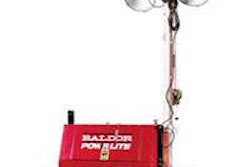 U.S. and European agencies collaborated to study each other’s de-icing practices. What came out of it was much more than just a few shared ideas and comradarie. A salt slurry spreader was developed and now a handful of areas in the country are experimenting with the system and saving their salt supply and reducing residual on the roads in the process.
U.S. and European agencies collaborated to study each other’s de-icing practices. What came out of it was much more than just a few shared ideas and comradarie. A salt slurry spreader was developed and now a handful of areas in the country are experimenting with the system and saving their salt supply and reducing residual on the roads in the process.
With limited road salt availability and skyrocketing prices the past few years, several cities, municipalities and agencies have been looking for a way to maximize their salt supplies.
So Bret Hodne, public works director for the city of West Des Moines, Iowa, began looking at various types of material spreaders and pre-wet systems. In his research, he discovered that the Europeans were having great success with treating rock salt with liquid at rates up to 90 gallons per ton. In the United States, 8- to 12-gallons per ton was typically being used. “There were vast differences in what was going on in the two regions of the world,” Hodne tells Better Roads. But one of the main differences between the European and the U.S. programs was the type of salt being used.
“The European salt was very fine and ours was quite course,” Hodne points out. However, while the fine, heavily pre-wetted salt the Europeans were using was very effective at quickly melting snow and ice, they were having trouble with the material working for extended periods of time. “They were having major challenges with residual on their roadways,” he points out. “Since their salt was already very fine, this wasn’t going to be an easy problem to solve. They had been using the heavy pre-wetted salt for anti-icing, but they were having some challenges with traffic taking the product off the road before it could be effective. They also have been experimenting with sugar beet products as we have in the United States.” Hodne says the Europeans were interested in how U.S. agencies were using this product in its liquid blends. So representatives of European road agencies came to the United States a few years ago so they could look at each other’s practices to see what they could collaborate on as well as learn from each other.
That’s how the Salt Slurry Generator was conceived. In the United States, a European spreader had been introduced — an Epoke unit with the capability to pre-wet salt rates up to 90 gallons per ton. The spreader uses a system where liquid is sprayed up from tubes as the salt comes off the spinner. The unit also can be used for anti-icing as well. Hodne and the others involved the research and collaboration project decided they’d develop their own type of system. “Now the million dollar question: Why did we want to develop a slurry mix unit?” Hodne quips. “When looking at all the variables, I decided we needed to develop a unit that would do the following: have the ability to pre-wet at rates up to 90 gallons per ton; could reduce the gradation of salt so we could get quicker action if we wanted to; and would incorporate the liquid more effectively with the salt before it came off the spinner.”
Hodne and crew enlisted the help of Monroe Truck Equipment on the project and together they developed a roller mill system to adjust salt gradation. The equipment maker is began manufacturing the system.
Now West Des Moines, Iowa, has been using the system for the past two winters, and Hodne says it’s worked extremely well. “We have found very good success at a ratio of about 60 gallons per ton,” Hodne notes. “We have found very good success at a ratio of about 60 gallons per ton.” The city is using a blending liquid de-icer product that contains 80 percent salt brine, 10 percent Fusion or GeoMelt and 10 percent calcium chloride. “One of the areas we continue to experiment is the gradation of the salt,” Hodne says. “It appears that using finder salt during storms with higher pavement temperature and coarser salt for colder storms is where we are headed.” Hodne predicts that the system is a look at the way the industry is headed: more liquid and reduced granular usage. “With the slurry unit, we are reducing granular application by 25 to 30 percent,” he says. “This has a significant reduction on the overall chloride load on the environment.”
Mark DeVries, maintenance superintendent McHenry County, Illinois and chair of the American Public Works Association’s Winter Maintenance Subcommittee, has been providing input during this experimental stage. His district just purchased one spreader, but it didn’t arrive until March so this winter will be the first time the system is used there. But McHenry County has been striving for using 25 gallons of liquid per ton of salt, and he says the salt slurry spreader will be a big part of this. “Because the salt is being crushed, it’s being spread as smaller particles,” DeVrie says. “This dissolves more quickly than bigger particles so we won’t have to reapply as often and shouldn’t have any bounce or scatter. This will make a big difference with our salt supply.”
How it works:
Step 1: Rock salt or other free-flowing materials are conveyed or auger fed at a pre-determined rate to the salt slurry spreader.
Step 2: Material is then ground into fine particles (size can be adjusted) that closely resemble flakes. Rollers can open and clear any items that are too hard to be ground.
Step 3: Grinding the material into smaller particles and adding liquid, eliminates rock salt bouncing off the road surface.
Step 4: A liquid brine is sprayed onto the refined particles to create a “slurry” mixture. The smaller particle size allows the brine to more efficiently cover and fully encapsulate the granular material.
Step 5: The salt/brine “slurry” solution is dispersed in a variable pattern on the road surface.











